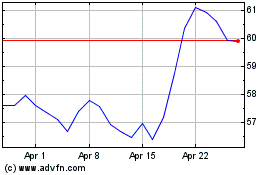By Rachel Louise Ensign and Andrew Ackerman
Washington has claimed its second Wells Fargo & Co. chief
executive.
John Stumpf quit the bank 13 days after a brutal appearance
before Congress. His successor, Timothy Sloan, lasted 16 days
before stepping down.
When Mr. Stumpf went to Congress in 2016 after a sales scandal
erupted at Wells Fargo, he blamed low-level employees and gave
evasive responses. Eager to avoid his predecessor's missteps, Mr.
Sloan prepared for his most recent appearance before Congress by
sounding out lawmakers and showcasing the bank's efforts to regain
customer trust.
But it was too late. By the time Mr. Sloan took his seat before
the House Financial Services Committee earlier this month, Wells
Fargo was on the outs with Washington. Problems had emerged across
the bank's other businesses, setting off a flurry of government
investigations. The Office of the Comptroller of the Currency and
the Federal Reserve, the bank's main regulators, were losing
patience.
The OCC was debating the rare step of forcing changes to Wells
Fargo's senior management or board, The Wall Street Journal has
reported. The Federal Reserve was showing no signs it was ready to
lift an unprecedented cap on the bank's growth put in place a year
earlier.
By stepping into the spotlight, Mr. Sloan invited a series of
public condemnations from the OCC and Fed. It was an unusual, if
indirect, show of force that effectively ended his career.
When Mr. Sloan entered the hearing room in the Rayburn office
building on March 12, he shook hands with House Financial Services
Committee members before taking his seat before the microphone.
In the weeks leading up to the hearing, Mr. Sloan had waged a
charm offensive on lawmakers from both parties. He traveled from
office to office, armed with presentations that showed improving
customer-service and employee-satisfaction metrics.
All the big-bank CEOs had been summoned to the Hill after the
Democrats gained control of the House of Representatives in
November. But Mr. Sloan was the only one testifying alone; his
counterparts were all set to appear together at a hearing in
April.
The committee -- led by California Democrat Maxine Waters --
initially asked the CEOs of the six biggest U.S. banks to testify
on March 12, people familiar with the matter said. A number of the
banks declined, saying a date in April, when they planned to be in
Washington for other meetings, would be better, the people
said.
Wells Fargo said Mr. Sloan was available. The bank was eager to
repair its relationship with Washington.
Rep. Waters had made it clear Wells Fargo would be a priority on
her watch. A hearing date was set.
During the hearing, Mr. Sloan faced a barrage of tough questions
from both sides of the aisle. He appeared worn but never lost his
composure, saying repeatedly that the bank was trying hard to
change its ways.
Rep. Waters got the last word, calling on the OCC to consider
removing Mr. Sloan. Dogged by protesters in the audience, Mr. Sloan
approached the dais to shake her hand.
Some lawmakers who had met with Mr. Sloan in the days before the
hearing were frustrated by his answers.
Rep. Brad Sherman (D., Calif.) became irritated during the
hearing after Mr. Sloan declined to take a position on legislation
to protect consumers against unreasonable overdraft fees. "He
bobbed and weaved and filibustered and wouldn't give us a straight
answer," Mr. Sherman said in an interview.
Still, Mr. Sloan had avoided a repeat of Mr. Stumpf's disastrous
appearance before the Senate Banking Committee in 2016. But it
didn't move the needle with regulators.
Minutes after the hearing ended, the OCC released a rare
statement rebuking the bank, saying it was "disappointed with
[Wells Fargo's] performance under our consent orders and its
inability to execute effective corporate governance and a
successful risk management program."
A week later, Federal Reserve Chairman Jerome Powell took aim at
the bank's system meant to prevent problems that could harm
customers. The risk-management framework, he said, had experienced
a "remarkably widespread series of breakdowns."
Mr. Powell said the Fed wouldn't lift the bank's asset cap
"until Wells Fargo gets their arms around this, comes forward with
plans, implements those plans, and we're satisfied with what
they've done. And that's not where we are right now."
The harsh words from regulators left Mr. Sloan with little
option but to resign, according to people familiar with the matter.
He stepped down Thursday, and the bank's board is looking for an
outsider to take his place.
"I could not keep myself in a position where I was becoming a
distraction." Mr. Sloan said Thursday.
Within the bank, Mr. Sloan's announcement was met with mixed
emotions. Some took it as a sign that Wells Fargo was finally
moving on from the fake-account scandal, people familiar with the
matter said. In an internal note reviewed by the Journal, the
bank's top wealth-management executive advised employees to stay
"calm and strong."
Others were disturbed, the people said. Washington, they were
convinced, had taken out the CEO of a private-sector company.
Write to Rachel Louise Ensign at rachel.ensign@wsj.com and
Andrew Ackerman at andrew.ackerman@wsj.com
(END) Dow Jones Newswires
March 30, 2019 09:14 ET (13:14 GMT)
Copyright (c) 2019 Dow Jones & Company, Inc.
Wells Fargo (NYSE:WFC)
Historical Stock Chart
From Oct 2024 to Nov 2024

Wells Fargo (NYSE:WFC)
Historical Stock Chart
From Nov 2023 to Nov 2024
